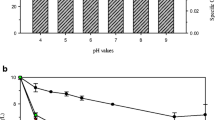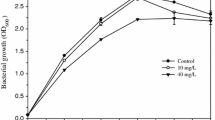Abstract
The present work highlighted the studies on Cr(VI) reduction by cells of Acinetobacter haemolyticus (A. haemolyticus). The strain tolerated 90 mg Cr(VI) l−1 in LB broth compared to only 30 mg Cr(VI) l−1 in LB agar. From the FTIR analysis, the Cr(III) species formed was also most likely to form complexes with carboxyl, hydroxyl, and amide groups from the bacteria. A TEM study showed the absence of precipitates on the cell wall region of the bacteria. Instead, microprecipitates were observed in the cytoplasmic region of the cells, suggesting the transportation of Cr(VI) into the cells. Intracellular reduction of Cr(VI) was supported by a reductase test using soluble crude cell-free extracts. The specific reductase activity obtained was 0.52 µg Cr(VI) reduced per mg of protein an hour at pH 7.2 and 37°C. Our results indicated that A. haemolyticus can be used as a promising microorganism for Cr(VI) reduction from industrial wastewaters.





Similar content being viewed by others
References
Abboud R, Popa R, Souza-Egipsy V, Giometti CS, Tollaksen S, Mosher JJ, Findlay RH, Nealson KH et al (2005) Low-temperature growth of Shewanella oneidensis MR-1. Appl Environ Microbiol 71:811–816. doi:10.1128/AEM.71.2.811-816.2005
Ackerley DF, Barak Y, Lynch SV, Curtin J, Matin A et al (2006) Effect of chromate stress on Escherichia coli K-12. J Bacteriol 188:3371–3381. doi:10.1128/JB.188.9.3371-3381.2006
Angle JS, Chaney RL (1989) Cadmium resistance screening in nitrilotriacetate-buffered minimal media. Appl Environ Microbiol 55:2101–2104
Bencheikh-Latmani R, Obraztsova A, Mackey M, Ellisman M, Tebo B et al (2007) Toxicity of Cr(III) to Shewanella sp. strain MR-4 during Cr(VI) reduction. Environ Sci Technol 41:214–220. doi:10.1021/es0622655
Boyanov MI, Kelly SD, Kemner KM, Bunker BA, Fein JB, Fowles DA et al (2003) Adsorption of cadmium to Bacillus subtilis bacterial cell walls: a pH-dependent x-ray absorption fine structure spectroscopy study. Geochim Cosmochim Acta 67:3299–3311. doi:10.1016/S0016-7037(02)01343-1
Bueno BYM, Toremd ML, Molina F, Mesquita LMS et al (2008) Biosorption of lead(II), chromium(III), and copper(II) by R. opacus: equilibrium and kinetic studies. Miner Eng 21:65–75. doi:10.1016/j.mineng.2007.08.013
Camargo FAO, Okeke BC, Bento FM, Frankenberger WY et al (2005) Diversity of chromium-resistant bacteria isolated from soils contaminated with dichromate. Appl Soil Ecol 29:193–202. doi:10.1016/j.apsoil.2004.10.006
Caravelli AH, Giannuzzi L, Zaritzky NE et al (2008) Reduction of hexavalent chromium by Sphaerotilus natans a filamentous micro-organism present in activated sludges. J Hazard Mater 156:214–222. doi:10.1016/j.jhazmat.2007.12.014
Cervantes C, Campos-Garcia J (2007) Reduction and efflux of chromate by bacteria. Mol Microb Heavy Metals Springer-Verlag, Berlin
Cervantes C, Campos-García J, Devars S, Gutiérrez-Corona F, Loza-Tavera H, Torres-Guzmán JC, Moreno-Sánchez R et al (2001) Interactions of chromium with microorganisms and plants. FEMS Microbiol Rev 25:335–347. doi:10.1111/j.1574-6976.2001.tb00581.x
Das SK, Guha AK (2007) Biosorption of chromium by Termitomyces clypeatus. Colloids Surf B Biointerfaces 60:46–54. doi:10.1016/j.colsurfb.2007.05.021
Daulton TL, Little BJ, Jones-Meehan J, Blom DA, Allard LF et al (2007) Microbial reduction of chromium from the hexavalent to divalent state. Geochim Cosmochim Acta 71:556–565. doi:10.1016/j.gca.2006.10.007
Desai C, Jain K, Madamwar D et al (2008) Evaluation of in vitro Cr(VI) reduction potential in cytosolic extracts of three indigeneous Bacillus sp. isolated from Cr(VI) polluted industrial landfill. Bioresour Technol 99:6059–6069
Eccles H (1995) Removal of heavy metals from effluent streams: why select a biological process? Int Biodeterior Biodegradation 35:5–16. doi:10.1016/0964-8305(95)00044-6
Gonzalez CF, Ackerley DF, Park CH, Matin A et al (2003) A soluble flavoprotein contributes to chromate reduction and tolerance by Pseudomonas putida. Acta Biotechnol 2–3:233–239. doi:10.1002/abio.200390030
Hassen A, Saidi N, Cherif M, Boudabous A et al (1998) Resistance of environmental bacteria to heavy metals. Bioresour Technol 64:7–15. doi:10.1016/S0960-8524(97)00161-2
Kamnev AA, Ristić M, Antonyuka LP, Chernyshev AV, Ignatov VV et al (1997) Fourier transform infrared spectroscopic study of intact cells of the nitrogen-fixing bacterium Azospirillum brasdense. J Mol Struct 408/409:201–205. doi:10.1016/S0022-2860(96)09532-4
Katz SA, Salem H (1994) The biological and chemistry of environmental chromium. VCH Publishers, USA
Lameiras S, Quintelas C, Tavares T (2008) Biosorption of Cr(VI) using a bacterial biofilm supported on granular activated carbon and on zeolite. Bioresour Technol 99:801–806. doi:10.1016/j.biortech.2007.01.040
Lin Z, Zhu Y, Kalabegishvili TL, Tsibakhashvili NY, Holman HY et al (2006) Effect of chromate action on morphology of basalt-inhabiting bacteria. Mater Sci Eng 26:610–612. doi:10.1016/j.msec.2005.06.058
Losi ME, Amrhein C, Frankenberger WT et al (1994) Environmental biochemistry of chromium. Rev Environ Contam Toxicol 36:91–121
Lowry OH, Rosebrough NJ, Farr AL, Randall RJ et al (1951) Protein measurements with Folin phenol reagents. J Biol Chem 193:265–275
McLean J, Beveridge TJ (2001) Chromate reduction by a Pseudomonad isolated from a site contaminated with chromated copper arsenate. Appl Environ Microbiol 67:1076–1084. doi:10.1128/AEM.67.3.1076-1084.2001
Megharaj M, Avudainayagam S, Naidu R et al (2003) Toxicity of hexavalent chromium and its reduction by bacteria isolated from soil contaminated with tannery waste. Curr Microbiol 47:51–54. doi:10.1007/s00284-002-3889-0
Mungasavalli DP, Viraraghavan T, Jin YC et al (2007) Biosorption of chromium from aqueous solutions by pretreated Aspergillus niger: batch and column studies. Colloids Surf A Physicochem Eng Asp 301:214–223. doi:10.1016/j.colsurfa.2006.12.060
Niftrik LV, Geerts WJC, Donselaar EGV, Humbel BM, Yakushevska A, Verkleij AJ, Jetten MSM, Strous M et al (2008) Combined structural and chemical analysis of the anammoxosome: a membrane-bounded intracytoplasmic compartment in anammox bacteria. J Struct Biol 161:401–410. doi:10.1016/j.jsb.2007.05.005
Ohtake H, Cervantes C, Silver S et al (1987) Decreased chromate uptake in Pseudomonas fluorescens carrying a chromate resistant plasmid. J Bacteriol 169:3853–3856
Pal A, Paul AK (2004) Aerobic chromate reduction by chromium-resistant bacteria isolated from serpentine soil. Microbiol Res 159:347–354. doi:10.1016/j.micres.2004.08.001
Pandi M, Shashirekha V, Swamy M et al. (2007) Bioabsorption of chromium from retan chrome liquor by cyanobacteria (in press)
Park D, Yun YS, Park JM et al (2005) Studies on hexavalent chromium biosorption by chemically-treated biomass of Ecklonia sp. Chemosphere 60:1356–1364. doi:10.1016/j.chemosphere.2005.02.020
Sarangi A, Krishnan C (2008) Comparison of in vitro Cr(VI) reduction by CFEs of chromate resistant bacteria isolated from chromate contaminated soil. Bioresour Technol 99(10):4130–4137
Shakoori AR, Makhdoom M, Haq RU et al (2000) Hexavalent chromium reduction by a dichromate-resistant gram-positive bacterium isolated from effluents of tanneries. Appl Microbiol Biotechnol 53:348–351. doi:10.1007/s002530050033
Shen H, Wang YT (1993) Characterization of enzymatic reduction of hexavalent chromium by Escherichia coli ATCC 33456. Appl Environ Microbiol 59:3771–3777
Srivastava S, Thakur IS (2007) Evaluation of biosorption potency of Acinetobacter sp for removal of hexavalent chromium from tannery effluent. Biodegradation 18:637–646. doi:10.1007/s10532-006-9096-0
Suzuki T, Miyata N, Horitsu H, Kawai K, Takamizawa K, Tai Y, Okazaki M et al (1992) NAD(P)H-dependent chromium(VI) reductase of Pseudomonas ambigua G-1: a Cr(V) intermediate is formed during the reduction of Cr(VI) to Cr(III). J Bacteriol 174:5340–5345
Thacker U, Parikh R, Shouche Y, Madamwar D et al (2006) Hexavalent chromium reduction by Providencia sp. Process Biochem 41:1332–1337. doi:10.1016/j.procbio.2006.01.006
Thacker U, Parikh R, Shouche Y, Madamwar D et al (2007) Reduction of chromate by cell-free extract of Brucella sp. isolated from Cr(VI) contaminated sites. Bioresour Technol 98:1541–1547. doi:10.1016/j.biortech.2006.06.011
Viamajala S, Smith WA, Sani RK, Apel WA, Petersen JN, Neal AL, Roberto FF, Newby DT, Peyton BM et al (2007) Isolation and characterization of Cr(VI)-reducing Cellulomonas spp from subsurface soils: implications for long-term chromate reduction. Bioresour Technol 98:612–622. doi:10.1016/j.biortech.2006.02.023
Wang YT, Xiao C (1995) Factors affecting hexavalent chromium reduction in pure cultures of bacteria. Water Res 29:2467–2474. doi:10.1016/0043-1354(95)00093-Z
Zakaria ZA, Zakaria Z, Surif S, Ahmad WA et al (2007) Hexavalent chromium reduction by Acinetobacter haemolyticus isolated from heavy metal-contaminated wastewater. J Hazard Mater 146:30–38. doi:10.1016/j.jhazmat.2006.11.052
Zhu W, Chai L, Ma Z, Wang Y, Xiao H, Zhao K, et al (2008) Anaerobic reduction of hexavalent chromium by bacterial cells of Achromobacter sp. strain Ch1. Microbiol Res 163(6):616–623
Acknowledgments
The authors acknowledge the contributions by Puan Aida Suhana bt. Rosly from the Electron Microscopy unit, Institute for Medical Research, Kuala Lumpur for invaluable help with the preparation of specimens for TEM analysis. Our sincere gratitude to the Ministry of Higher Education, Malaysia for funding of the project (FRGS) and the Ministry of Science, Technology and Innovation, Malaysia for the National Science Fellowship scholarship to Quek Hsiao Pei and the Postdoctoral Fellowship to Zainul Akmar Zakaria. Also to Dr. Peter Klappa, Department of Biochemistry, University Of Birmingham for proofreading of the manuscript.
Author information
Authors and Affiliations
Corresponding author
Rights and permissions
About this article
Cite this article
Pei, Q.H., Shahir, S., Santhana Raj, A.S. et al. Chromium(VI) resistance and removal by Acinetobacter haemolyticus . World J Microbiol Biotechnol 25, 1085–1093 (2009). https://doi.org/10.1007/s11274-009-9989-2
Received:
Accepted:
Published:
Issue Date:
DOI: https://doi.org/10.1007/s11274-009-9989-2




